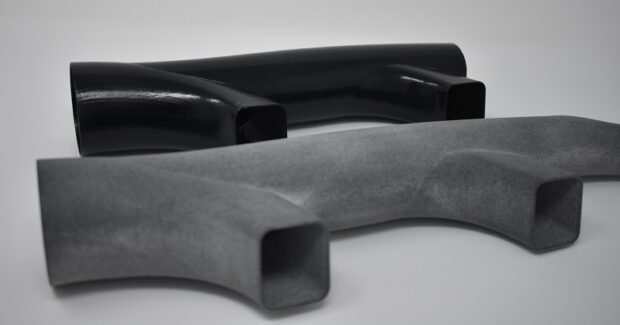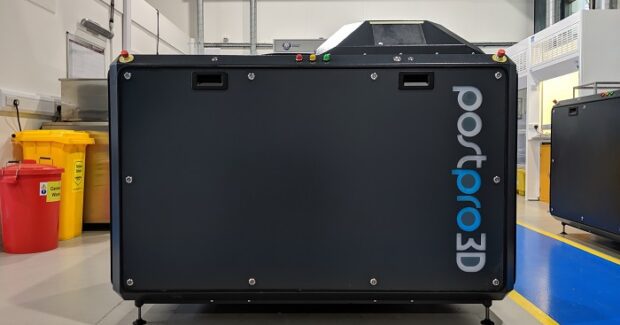Post-Processing: The Achilles Heel of Additive Manufacturing
Surface finishing and other post-processing requirements for AM production applications can run up to 60 percent of the total cost per finished part. Here’s how more capable and connected systems can simplify the overall process chain, provide economically viable parts and improve operational sustainability, cost, and timeliness.
Posted: October 7, 2019
How ironic is it that additive manufacturing – the technology at the vanguard of the digital manufacturing revolution – still requires almost prehistoric levels of manual intervention at the post processing stage, slowing down the entire process chain for production applications and potentially impacting the geometric and functional integrity of the finished parts that are being built. Many shops underestimate the post-processing requirements involved in using AM as a production tool. Due to cost and time implications, post-processing can be considered a barrier to moving AM technologies into production applications – it’s the Achilles heel that runs up to 60 percent of total cost per finished part due to labor-intensive surface finishing and other time-consuming activities. Though some post-processing issues can be reduced through diligent focus on design for AM, post-processing is still needed in all AM processes, no matter how good the design.
To address this puzzle, all of the steps involved from product design to final end-use product or component must be analyzed to develop an ecosystem approach to each individual AM production application – from end to end, connecting the dots from product conception through to final product. For example, many thermoplastic materials are available for use on a variety of AM platforms, but powder-bed processes require significant powder handling and removal post-build, along with infiltration operations, finishing and coloring processes, particularly if aesthetics are important alongside the strength advantages that powder bed fusion technologies offer. Filament thermoplastic material processes, however sophisticated, always produce a stepping effect on the parts being built that is very costly and time-consuming to eliminate via conventional post-processing processes. We address this with a PostPro3D® automated post-processing system that smooths high volumes of thermoplastic polymer parts to an injection-molded surface quality and removes one of the biggest hurdles to the serial production process chain.
By integrating new systems, software and virtual services, the PostPro3D hardware simply and efficiently removes the AM-produced part from the machine, loads it onto a rack and places it into a post-processing chamber. The user then selects the appropriate program, the process starts and runs for 90 to 120 minutes, then the parts are removed, inspected and fit for purpose. This post-processing technology is a physiochemical process that involves converting a proprietary solvent into vapor under precisely-controlled vacuum and temperature conditions to refine the surface of each part and ensure a perfectly smooth finish, equivalent to that of an injection-molded part. The chemicals used in this smoothing process are a proprietary mix of organic solvents developed by the University of Sheffield that are non-flammable and non-explosive. In fact, these chemicals have been carefully developed to be precursors and metabolites of those already used in the medical industry in FDA-approved medical-grade medicines, minimizing any potential issues with regard to human contact and environmental issues.
The chemicals are inserted into the PostPro3D machine via a cartridge and are used in a completely closed system where there is no chance of direct contact with the user. Subsequent to completion of the process, parts are completely free from chemical residues, and post-processed parts are certified and biocompatible for medical device use under ISO 10993. They have also been tested to show they have no cytotoxic effect. Because the PostPro3D is a closed-loop system, there is no waste stream for operators to dispose of. The machines require periodic maintenance by qualified technicians, during which recycled consumables and carbon filters are collected and changed. This is the only post-processing ecosystem in the world that does not have any waste streams from products or require the use of water. Additional safety features include multiple system redundancy and failsafe procedures with remote alarm transmission via internet connection, and 24/7 automatic remote monitoring of machine through a 3G cellular network.
The PostPro3D automatic post-processing system is a CE and UL-listed machine with zero waste and optimized power consumption that advances the use of AM in an advanced digital manufacturing system. This system addresses the drawbacks to post-processing and is running with multiple blue-chip OEMs across the globe, including heavily regulated environmental jurisdictions such as California. It is a next step in developing whole process chains of more capable and connected systems that simplify the overall process and enable manufacturers to transition to AM for an increasing number of production applications.

















